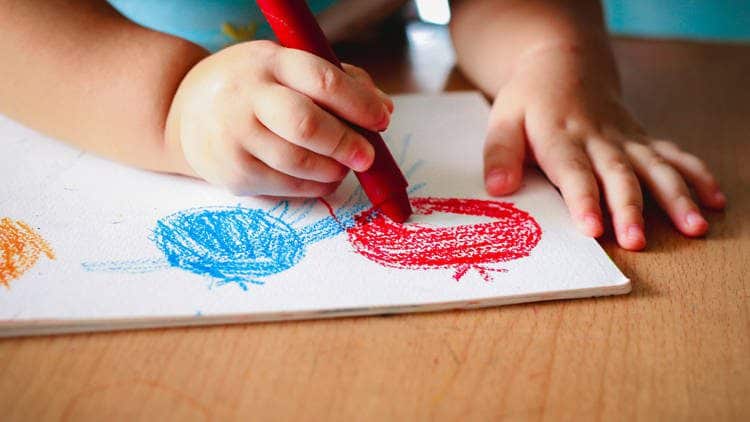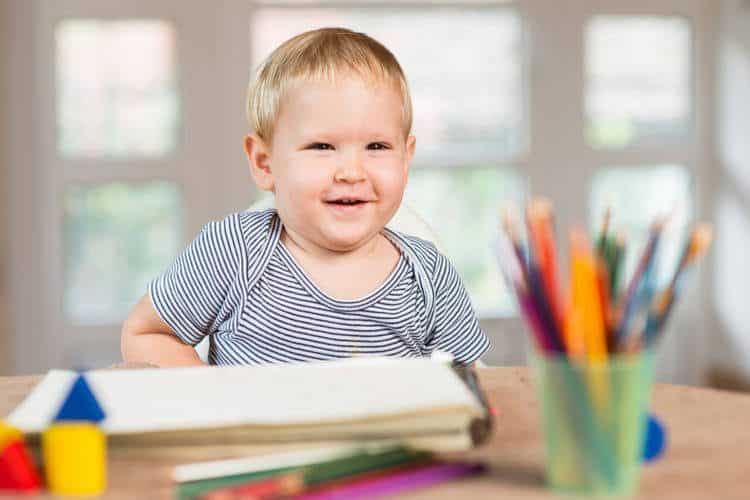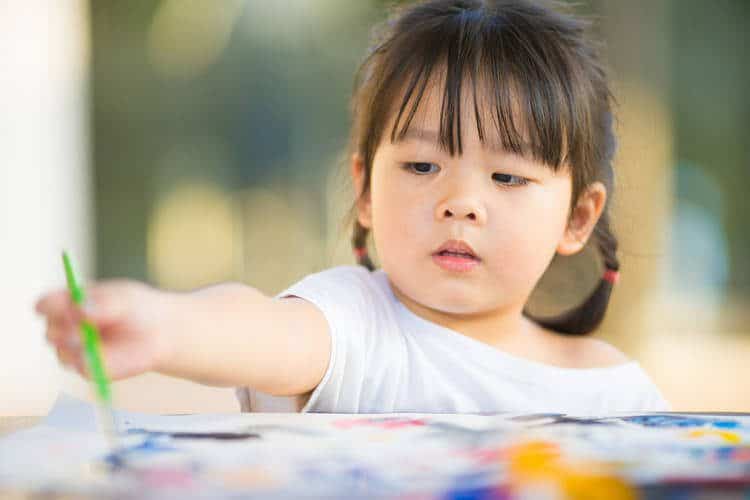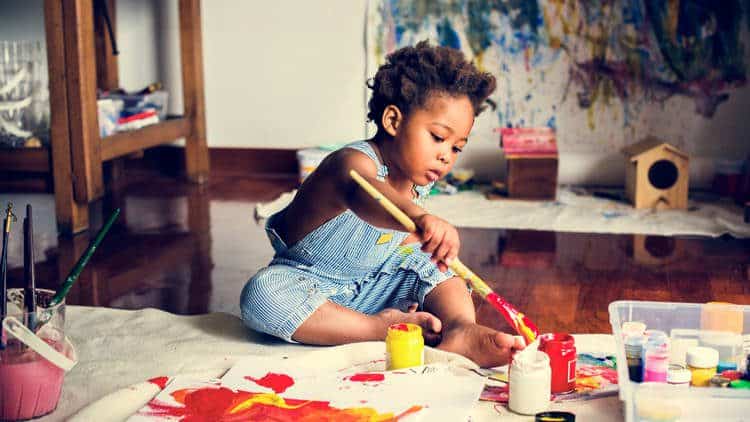Learning to Write and Draw

Key Takeaways
- How Your Child’s Writing and Art Changes Over Time
- Stage 1: Random Scribbling (15 months to 2½ years)
- Stage 2: Controlled Scribbling (2 years to 3 years)
- Stage 3: Lines and Patterns (2½ years to 3½ years)
- Stage 4: Pictures of Objects or People (3 years to 5 years)
- Stage 5: Letter and Word Practice (3 to 5 years)
- What Can You Do to Encourage Art and Writing Skills
How A Child’s Writing and Art Changes Over Time
Creativity is a bridge to learning. When a child is creative and curious, she can come up with answers to the problems she encounters—like how to keep the block tower from falling. Creativity helps a child become a thoughtful, inquisitive, and confident learner later on, when she starts school.
One of the most important ways that a toddler is tuning into her creativity is by experimenting with art materials. As she grabs that chunky crayon and gets to work, you will see her art and writing change and become more controlled and complex as she grows.
For very young children, art and early writing skills are one and the same. At first, it’s all about just figuring out what these cool things called crayons can do. Then the child discovers the link between her hand holding the crayon and the line she made on the page: Presto! She experiences the power of cause-and-effect. Imagine how exciting this must be for her! She can now make a real “mark” on the world. This leap in thinking skills is helped along by her new ability to hold things in her hands and fingers. The growing control a child has over the muscles in her hands lets her move a marker or paintbrush with purpose and with a goal in mind.
For very young children, there are four stages of drawing and writing that you may see as a child grows from 15 months old to 3 years old. Note that the timetables listed below are approximate; the child may master these skills faster or slower and still be developing just fine. Growth doesn’t happen at the same speed for every child, but by offering repeated fun experiences with a variety of art and writing materials, you will see forward progress over time.
Stage 1: Random Scribbling (15 months to 2½ years)
This is the period when young children are just figuring out that their movements result in the lines and scribbles they see on the page. These scribbles are usually the result of large movements from the shoulder, with the crayon or marker held in the child’s fist. There is joy in creating art at all ages, but at this stage especially, many children relish the feedback they are getting from their senses: the way the crayon feels, the smell of the paint, the squishy-ness of the clay.
For other children, this sensory information may be too much and they may not enjoy some art activities at this stage (like finger-painting). As they grow to tolerate more sensory input, you can incrementally re-introduce art activities into their routine.
Stage 2: Controlled Scribbling (2 years to 3 years)
As children develop better control over the muscles in their hands and fingers, their scribbles begin to change and become more controlled. Toddlers may make repeated marks on the page—open circles, diagonal, curved, horizontal, or vertical lines. Over time, children make the transition to holding the crayon or marker between their thumb and pointer finger.
Stage 3: Lines and Patterns (2½ years to 3½ years)
Children now understand that writing is made up of lines, curves, and repeated patterns. They try to imitate this in their own writing. So while they may not write actual letters, you may see components of letters in their drawing. These might include lines, dots, and curves. This is an exciting time as a toddler realizes that his drawing conveys meaning! For example, he may write something down and then tell you what word it says. This is an important step toward reading and writing.
Stage 4: Pictures of Objects or People (3 years to 5 years)
Many adults think of “pictures” as a picture of something. This ability to hold an image in your mind and then represent it on the page is a thinking skill that takes some time to develop. At first, children name their unplanned creations. This means that they finish the picture and then label their masterpiece with the names of people, animals, or objects they are familiar with. This changes over time.
Soon you will see the child clearly planning prior to drawing what he will create. You will also see more detail in the pictures, more control in the way the child handles the crayon or marker, and the use of more colors. What else to be on the lookout for? Children’s first pictures often build off circles. So, you may see a sun—an irregular circle, with lots of stick “rays” shooting out—or a person (usually a circle with roughly recognizable human features).
Once a child has begun to purposefully draw images, she has mastered symbolic thinking. This important milestone in thinking skills means that a child understands that lines on paper can be a symbol of something else, like a house, a cat, or a person. At this stage, the child also begins to understand the difference between pictures and writing. So you may see him draw a picture and then scribble some “words” underneath to describe what he has drawn or to tell a story. When a child is able to share his story with you, he will be motivated to “author” more and more work as he grows.
Stage 5: Letter and Word Practice (3 to 5 years)
Children have had experience with letters and print for several years now and are beginning to use letters in their own writing. Usually children start by experimenting with the letters in their own names, as these are most familiar to them. They also make “pretend letters” by copying familiar letter shapes, and will often assume that their created letter must be real because it looks like other letters they have seen (Robertson, 2007).
During this time, children also begin to understand that some words are made of symbols that are shorter and some words are made of symbols that are longer. As a result, their scribbles change. Rather than one long string of letters or letter-like shapes, a child’s writing now has short and long patterns that look like words or sentences. While these letters and words are probably not technically correct, it does not matter. This exciting milestone means that the child is beginning to understand that text and print have meaning.
How to Encourage Art and Writing Skills
No need for instructions.
Let children experiment and explore. Creativity means having the power to express yourself in your own way (Lagoni et al., 1989). This independence is just what a growing toddler is looking for to feel confident, competent, and clever. By sitting nearby, observing, and taking pleasure in your child’s creation, you are providing all the guidance he needs.
Notice the process, not just the product.
As parents, we often tend to compliment children on their successes: What’s that a picture of? A house? That’s great! And sometimes we get hung up on the fact that trees should be green, not purple. Sometimes we quiz: What’s the name of that color? But children learn more when we don’t focus so much on what they are drawing, but on what they are thinking about their drawing. Take a few moments to observe a child’s work: Look at the lines you are making—there are so many of them! Or, That picture is really interesting. Those colors make me feel happy. Or, I see you are working really hard on your drawing. Or just: Tell me about your picture. Then see if the child is interested in sharing more.
Experiment with a variety of art materials as your child nears 3.
Let children paint with cotton balls, q-tips, sponges, string—you name it. Give a child crayons and rub over a textured surface (like a coin or a screen). Draw with chalk outside on a sidewalk; see how water changes the color of the chalk. Add powdered paint or glitter to a child’s sand play. Or add a new dimension to water play by adding drops of washable food coloring to the water. What happens when you mix two different colors of water together?
Use art to help a child express strong feelings.
Is the child having a tantrum? Offer some play-dough or set out the markers and paper and suggest she make a very, very angry picture. Creative activities can sometimes help children express and make sense of feelings that are too intense for them to share in words.
Encourage a child’s attempts to write.
If the child scribbles something and then tells you what he “wrote,” take it seriously. Let him take his “shopping list” to the supermarket or mail his (scribbled) letter to Grandma. This is how children learn that words are powerful and have meaning.
Display your child’s art and writing.
This is how a child knows her work is valued and important.
Creative activities help children to learn how to solve problems, come up with their own answers, discover the cause-and-effect of their actions, and feel confident about the choices they make. Art experiences help children develop independence within limits, and gives them the opportunity to represent their ideas on paper or in other formats. Most important, creative expression lets children tap into the magic of their own imaginations—which is what being a child is all about.
Resources and References
Farrell-Kirk, R. (2007 February). Tips on understanding and encouraging your child’s artistic development. Downloaded on June 10, 2008.
Gable, S. (2000). Creativity in young children. University of Missouri Extension. Downloaded on June 10, 2008.
Kentucky Cooperative Extension Service. (n.d.). My child is an artist! The stages of artistic development. Downloaded on June 10, 2008.
Lagoni, L. S., Martin, D. H., Maslin-Cole, C., Cook, A., MacIsaac, K., Parrill, G., Bigner, J., Coker, E., & Sheie, S. (1989). Good times being creative. In Good times with child care (pp. 239–253). Fort Collins, CO: Colorado State University Cooperative Extension. Downloaded on June 10, 2008.
Levinger, L, & Mott, A. (n.d.). Developmental phases in art. Downloaded on June 10, 2008.
Robertson, R. (2007, July/August). The meaning of marks: Understanding and nurturing young children’s writing development. Child Care Exchange, 176, 40–44.



